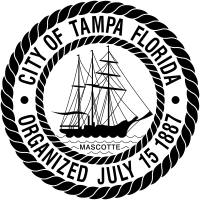
The Seal of the City of Tampa is Tampa government's official seal. The seal was made in Italy in the 1920s by Val Antuono, Sr. [1]

The Seal of the City of Tampa is Tampa government's official seal. The seal was made in Italy in the 1920s by Val Antuono, Sr. [1]
In the center of the seal is a (historically inaccurate [2] ) depiction of the steamship Mascotte, which was owned by Henry B. Plant and was named after the operetta La mascotte by Edmond Audran. [1] The ship (along with its sister ship Ollivette, which was also named for an opera by Audran) ran between Tampa, Key West, and Cuba from the mid-1880s until the early 1900s. [3] It was in that capacity that it brought thousands of immigrants and regular shipments of clear Havana tobacco to Ybor City and West Tampa, helping to make Tampa the Cigar Capital of the World [4]
The outside parameter of the city seal shows the "City of Tampa Florida" and "July 15, 1887", the date on which the city was organized under a special act of the Florida Legislature. The seal shown was created by Margaret Joan Hug, a city of Tampa employee. She created (updated) the seal in the late 1970s or early 1980s. Margaret was born on April 4, 1934, in Detroit, Michigan
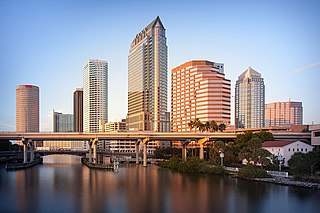
Tampa is a city on the Gulf Coast of the U.S. state of Florida. The city's borders include the north shore of Tampa Bay and the east shore of Old Tampa Bay. Tampa is the largest city in the Tampa Bay area and the seat of Hillsborough County. With a population of 384,959 according to the 2020 census, Tampa is the third-most populated city in Florida after Jacksonville and Miami and is the 52nd most populated city in the United States.

Mascotte is a city in Lake County, Florida, United States. As of the 2020 census, the population was 6,609, up from 5,101 in 2010. It is part of the Orlando–Kissimmee–Sanford Metropolitan Statistical Area.
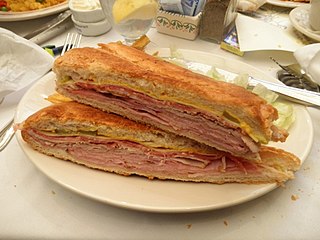
A Cuban sandwich is a variation of a ham and cheese sandwich that likely originated in cafes catering to Cuban workers in Tampa or Key West, two early Cuban immigrant communities in Florida centered on the cigar industry. Later on, Cuban exiles and expatriates brought it to Miami, where it is also very popular. The sandwich is made with ham, (mojo) roasted pork, Swiss cheese, pickles, mustard, and sometimes salami on Cuban bread. Salami is included in Tampa, where there is a large Italian population, but is not usually included in South Florida.

Ybor City is a historic neighborhood just northeast of downtown Tampa, Florida, United States. It was founded in the 1880s by Vicente Martinez-Ybor and other cigar manufacturers and populated by thousands of immigrants, mainly from Cuba, Spain, and Italy. For the next 50 years, workers in Ybor City's cigar factories rolled hundreds of millions of cigars annually.

West Tampa is one of the oldest neighborhoods within the city limits of Tampa, Florida, United States. It was an independently incorporated city from 1895 until 1925, when it was annexed by Tampa.

Cuban bread is a fairly simple white bread, similar to French bread and Italian bread, but has a slightly different baking method and ingredient list ; it is usually made in long, baguette-like loaves. It is a staple of Cuban-American cuisine and is traditionally the bread of choice when making an authentic Cuban sandwich.
The modern history of Tampa, Florida, can be traced to the founding of Fort Brooke at the mouth of the Hillsborough River in today's downtown in 1824, soon after the United States had taken possession of Florida from Spain. The outpost brought a small population of civilians to the area, and the town of Tampa was first incorporated in 1855.
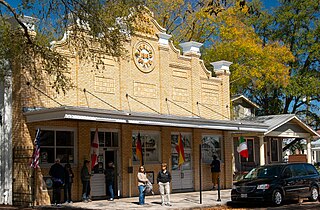
Ybor City Museum State Park is a Florida State Park in Tampa, Florida's Ybor City. The museum occupies the former Ferlita Bakery building at 1818 9th Avenue in the Ybor City Historic District. The bakery was known for producing cuban bread and its ovens are part of the museum displays covering the history of the cigar industry and the Latin community from the 1880s through the 1930s. There is also an ornamental garden in the building.

For the similarly named building in West Tampa see El Centro Español of West Tampa

The Ybor Factory Building is a historic site in Tampa, Florida, United States located at 1911 North 13th Street. The main factory and its surrounding support buildings cover an entire city block between 8th Avenue and 9th Avenues and 13th and 14th Streets in the Ybor City Historic District section of the Ybor City neighborhood. C. E. Parcell is credited as the building's architect.

Downtown Tampa is the central business district of Tampa, Florida, United States, and the chief financial district of the Tampa Bay Area.

V.M. Ybor is a neighborhood within the city limits of Tampa, Florida, United States. As of the 2010 census, the neighborhood had a population of 1,743. The ZIP Codes serving the neighborhood are 33602, 33603, and 33605.

Vicente Martinez Ybor, was a Spanish entrepreneur who first became a noted industrialist and cigar manufacturer in Cuba, then Key West, and finally Tampa, Florida.

Ybor City is a historic neighborhood that includes the Ybor City Historic District in Tampa, Florida. It is located just northeast of downtown Tampa and north of Port Tampa Bay. The neighborhood has distinct architectural, culinary, cultural, and historical legacy that reflects its multi-ethnic composition. It was unique in the American South as a prosperous manufacturing community built and populated almost entirely by immigrants.

Nicholas Chillura Nuccio was a two-time mayor of Tampa, Florida in the 1950s and 60s. He was the Tampa's first mayor of "Latin" descent, having been born and raised in the immigrant neighborhood of Ybor City.
Gary is an industrial section located in the southeastern part of Tampa, Florida, mainly in the vicinity of Adamo Drive east of Downtown Tampa.
The Tampa Smokers was a name used between 1919 and 1954 by a series of minor league baseball teams based in Tampa, Florida. The nickname was a nod to the local cigar industry, which was the most important industry in Tampa during the years in which the Smokers were active. During periods in which the name was not used by a professional team, various local semi-pro and amateur teams took up the Smokers name.
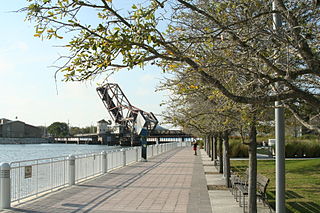
The Tampa Riverwalk is a 2.6-mile-long (4.2 km) open space and pedestrian trail along the Hillsborough River in Tampa, Florida. The Riverwalk extends along most of the downtown Tampa waterfront from the Channelside District on the eastern terminus to the mouth of the Hillsborough River and then north along the riverside to Tampa Heights, forming a continuous path that connects a multitude of parks, attractions, public spaces, and hotels. Among the notable points of interest along the Riverwalk are the Tampa Bay History Center, Amalie Arena, the Tampa Convention Center, Rivergate Tower, Curtis Hixon Waterfront Park, Water Works Park, and the Waterfront Arts District which includes the Tampa Museum of Art, Florida Museum of Photographic Arts, Glazer Children's Museum, and the Straz Center for the Performing Arts. Locations along the Riverwalk play host to many community events, most notably the numerous festivals held at Curtis Hixon Park and the arrival of the "pirate ship" Jose Gasparilla, which moors at the Riverwalk behind the Convention Center during the Gasparilla Pirate Festival.

Gavino Gutierrez, a Spanish immigrant to the United States, was an importer, architect, civil engineer, and surveyor. He was responsible for bringing Vincente M. Ybor to Tampa, Florida and for designing Ybor City.